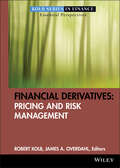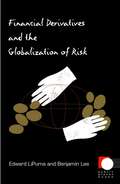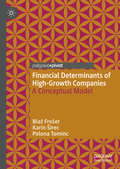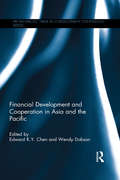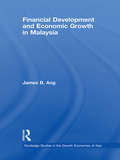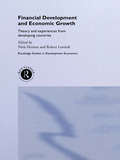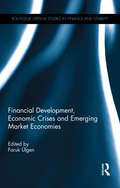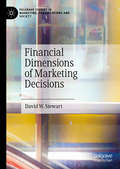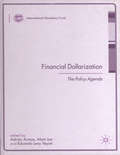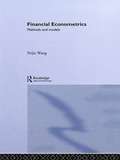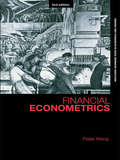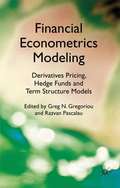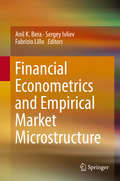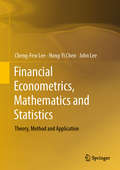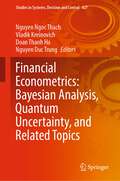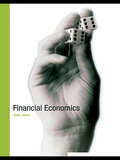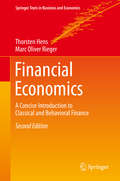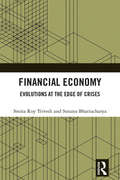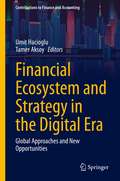- Table View
- List View
Financial Derivatives
by James A. Overdahl Robert KolbEssential insights on the various aspects of financial derivativesIf you want to understand derivatives without getting bogged down by the mathematics surrounding their pricing and valuation, Financial Derivatives is the book for you. Through in-depth insights gleaned from years of financial experience, Robert Kolb and James Overdahl clearly explain what derivatives are and how you can prudently use them within the context of your underlying business activities.Financial Derivatives introduces you to the wide range of markets for financial derivatives. This invaluable guide offers a broad overview of the different types of derivatives-futures, options, swaps, and structured products-while focusing on the principles that determine market prices. This comprehensive resource also provides a thorough introduction to financial derivatives and their importance to risk management in a corporate setting. Filled with helpful tables and charts, Financial Derivatives offers a wealth of knowledge on futures, options, swaps, financial engineering, and structured products.Discusses what derivatives are and how you can prudently implement them within the context of your underlying business activitiesProvides thorough coverage of financial derivatives and their role in risk managementExplores financial derivatives without getting bogged down by the mathematics surrounding their pricing and valuationThis informative guide will help you unlock the incredible potential of financial derivatives.
Financial Derivatives and the Globalization of Risk
by Benjamin Lee Edward LipumaThe market for financial derivatives is far and away the largest and most powerful market in the world, and it is growing exponentially. In 1970 the yearly valuation of financial derivatives was only a few million dollars. By 1980 the sum had swollen to nearly one hundred million dollars. By 1990 it had climbed to almost one hundred billion dollars, and in 2000 it approached one hundred trillion. Created and sustained by a small number of European and American banks, corporations, and hedge funds, the derivatives market has an enormous impact on the economies of nations--particularly poorer nations--because it controls the price of money. Derivatives bought and sold by means of computer keystrokes in London and New York affect the price of food, clothing, and housing in Johannesburg, Kuala Lumpur, and Buenos Aires. Arguing that social theorists concerned with globalization must familiarize themselves with the mechanisms of a world economy based on the rapid circulation of capital, Edward LiPuma and Benjamin Lee offer a concise introduction to financial derivatives. LiPuma and Lee explain how derivatives are essentially wagers--often on the fluctuations of national currencies--based on models that aggregate and price risk. They describe how these financial instruments are changing the face of capitalism, undermining the power of nations and perpetrating a new and less visible form of domination on postcolonial societies. As they ask: How does one know about, let alone demonstrate against, an unlisted, virtual, offshore corporation that operates in an unregulated electronic space using a secret proprietary trading strategy to buy and sell arcane financial instruments? LiPuma and Lee provide a necessary look at the obscure but consequential role of financial derivatives in the global economy.
Financial Derivatives: Pricing, Applications, and Mathematics
by Jamil Baz George ChackoCombining their corporate and academic experiences, Jamil Baz and George Chacko offer financial analysts a complete, succinct account of the principles of financial derivatives pricing. Readers with a basic knowledge of finance, calculus, probability and statistics will learn about the most powerful tools in applied finance: equity derivatives, interest rate markets, and the mathematics of pricing. Baz and Chacko apply concepts such as volatility and time, and generic pricing to the valuation of conventional and more specialized cases. Other topics include: *Interest rate markets, government and corporate bonds, swaps, caps, and swaptions *Factor models and term structure consistent models *Mathematical allocation decisions such as mean-reverting processes and jump processes *Stochastic calculus and related tools such as Kilmogorov equations, martingales techniques, stocastic control and partial differential equations Meant for financial analysts and graduate students in finance and economics, Financial Derivatives begins with basic economic principles of risk and builds up various pricing and hedging techniques from those principles. Baz and Chacko simplify the mathematical presentation, and balance theory and real analysis, making it a more accessible and practical manual. Jamil Baz holds an M. S. in Management from MIT and a Ph. D. in Business Economics from Harvard University. He is a Managing Director at Deutsche Bank in London. George Chacko has a B. S. from MIT in electrical engineering and a Ph. D. in Business Economics from Harvard University. He is an Associate Professor of Business Administration at Harvard Business School. Both authors have worked extensively for financial services firms in the private sector. They have published in leading academic journals including the Review of Financial Studies and the Journal of Financial Economics as well as practitioner journals such as the Journal of Fixed Income and the Journal of Applied Corporate Finance.
Financial Determinants of High-Growth Companies: A Conceptual Model
by Polona Tominc Blaž Frešer Karin ŠirecThis book explores the factors that contribute to high corporate growth, presenting a new conceptual model for research into this phenomenon.Building on existing research, the authors present a new conceptual research model that links multidimensional variables, such as entrepreneurial orientation, and human capital, with the perceived availability of different forms of financing for high-growth companies and with the measures that these firms take to overcome financial constraints and thus influence their financial performance. With this model the authors aim to enhance our understanding of the specifics of financing high growth companies and demonstrate how the availability of financial resources is one of the most important determinants of promoting development and enterprise growth. Empirically tested on a random sample of high-growth companies from Slovenia, the book seeks to make a contribution to research and enhance our understanding of the various factors involved in high growth firms.
Financial Development and Cooperation in Asia and the Pacific (PAFTAD (Pacific Trade and Development Conference Series))
by Wendy Dobson Edward K. ChenThe 1997–8 Asian financial crisis exposed weaknesses in the region’s national financial systems, but since then East Asia has become the world’s most dynamic economic region. Domestic financial systems have developed, cross-border financial flows within the region are growing apace as demand from governments and large firms increases and as the capabilities of financial institutions develop, and governments have initiated regional cooperation aimed at preventing future crises and managing them if they occur. This book examines the economies of Asia and the Pacific with reference to financial reform and liberalization, monetary policy frameworks, banking and capital markets, regulation and supervision and macroeconomic policies. Further, it asks what lessons have been learned from both the Asian financial crisis and the recent financial crisis, how to engender financial stability in the region, and how to ensure that the benefits of economic growth and financial development reach all members of society. Across four key sections, the chapters examine the future implications of historical studies of the relationships between financial development and growth; financial development including banks, non-bank financial institutions and capital markets; how financial stability is being sought in the region; and China’s plans for capital account opening and renminbi internationalization and subsequent the policy implications for China’s neighbours. This book draws on papers originally presented to the 36th Pacific Trade and Development Conference held in Hong Kong in 2013, and features contributions from leading academics and economists from around the world. As such, it will be of great interest to students and scholars of Asian economics, Asia Pacific studies, international economics and international finance.
Financial Development and Economic Growth in Malaysia (Routledge Studies in the Growth Economies of Asia)
by James B. AngThis book is concerned with the role of financial intermediation in economic development and growth in the context of Malaysia. Using an analytical framework, the author investigates the Malaysian economy from 1960 onwards to examine how far financial development has progressed in the course of economic development, and whether it has been instrumental in promoting economic growth. A significant improvement in the Malaysian financial system, coupled with rapid economic growth and a rich history of financial sector reforms, makes Malaysia an interesting case study for this subject. The author shows that some government interventions seem to have impacted negatively on economic growth, whereas repressionist financial policies such as interest rate controls, high reserve requirements and directed credit programmes seem to have contributed positively to financial development. The analysis concludes that financial development leads to higher output growth via promoting private saving and private investment. Shedding light on the evolutionary role of financial system and the interacting mechanisms between financial development and economic growth, this book will be of interest to those interested in economic and financial development, financial liberalization, saving behaviour and investment analysis and Asian Studies.
Financial Development and Economic Growth: Theory and Experiences from Developing Countries (Routledge Studies in Development Economics #No.6)
by Robert Lensink Niels HermesThis collection brings together a collection of theoretical and empirical findings on aspects of financial development and economic growth in developing countries. The book is divided into two parts: the first identifies and analyses the major theoretical issues using examples from developing countries to illustrate how these work in practice; the second part looks at the implications for financial policy in developing countries.
Financial Development in the Middle East and North Africa
by Rishi Goyal Susan Creane A. Mushfiq Mobarak Randa SabIn this study, the authors assess financial sector development in the MENA region and propose several policy measures, which include reinforcing the institutional environment and promoting nonbank financial sector development, to enhance this sector's performance.
Financial Development, Economic Crises and Emerging Market Economies (Routledge Critical Studies in Finance and Stability)
by Faruk UlgenRecurrent crises in emerging markets and in advanced economies in the last decades cast doubt about the ability of financial liberalization to meet the aims of sustainable economic growth and development. The increasing importance of financial markets and financial efficiency criterion over economic decisions and policies since the 1980s laid down the conditions of the development process of emerging market economies. Numerous crises experienced thereafter gave rise to flourishing work on the links between financialization and economic development. Several decades of observations and lessons can now be integrated into economic and econometric models to give more sophisticated and multivariable approaches to financial development with respect to growth and development issues. In the markets-based and private-enterprise dominated world economy, two conditions for a successful growth-enhancing financial evolution can at least be brought fore: macroeconomic stability and consistent supervision. But even after the 2007-2008 global crisis, economists do not agree on the meaning of those conditions. For liberal and equilibrium-market economists, good finance and supervision mean market-friendly structures while for institutionalists, post-Keynesian and Marxist economists, good finance and supervision must lie in collectively designed and managed public structures. Drawing heavily on the tumultuous crises of the 1990s-2000s, this book argues that those experiences can shed light on such a crucial issue and lead economic theory and policy to go beyond the blindness of efficient free markets doctrine to economic catastrophes. It also points to new challenges to global stability in the wake of reconfiguration of international financial arena under the weight of major emerging market economies.
Financial Dimensions of Marketing Decisions (Palgrave Studies in Marketing, Organizations and Society)
by David W. StewartThis book is about linking marketing activities and outcomes to the financial performance of the organization. The theme of the book is that the marketing function must justify its activities and use of resources in terms of its financial contributions to the firm. More specifically, the book focuses on how marketing activities generate cash flow, growth, and other financial benefits for the organization. This perspective provides a framework for long-term investments for purposes of evaluating and ranking the funding of proposed projects.
Financial Dollarization: The Policy Agenda
by Adrián Armas Alain Ize Eduardo Levy YeyatiFinancial (unofficial) dollarization is widely seen as a critical source of financial fragility in both developing and emerging economies. This volume provides a rigorous and balanced perspective on the causes and implications of dollarization, and the basic policies and options to deal with it: the adaptation of the monetary and prudential frameworks, the development of local-currency substitutes, and the scope for limiting dollarization through administrative restrictions.
Financial Econometrics
by Peijie WangThis book which provides an overview of contemporary topics related to the modelling of financial time series, is set against a backdrop of rapid expansions of interest in both the models themselves and the financial problems to which they are applied.This excellent textbook covers all the major developments in the area in recent years in an informative as well as succinct way.Refreshingly, every chapter has a section of two or more examples and a section of empirical literature, offering the reader the opportunity to practice the kind of research going on in the area. This approach helps the reader develop interest, confidence and momentum in learning contemporary econometric topics
Financial Econometrics (Routledge Advanced Texts In Economics And Finance Ser.)
by Peijie WangThis book provides an essential toolkit for all students wishing to know more about the modelling and analysis of financial data. Applications of econometric techniques are becoming increasingly common in the world of finance and this second edition of an established text covers the following key themes:- unit roots, cointegration and other develop
Financial Econometrics Modeling: Derivatives Pricing, Hedge Funds and Term Structure Models
by Greg N. Gregoriou Razvan PascalauThis book proposes new tools and models to price options, assess market volatility, and investigate the market efficiency hypothesis. In particular, it considers new models for hedge funds and derivatives of derivatives, and adds to the literature of testing for the efficiency of markets both theoretically and empirically.
Financial Econometrics Modeling: Market Microstructure, Factor Models and Financial Risk Measures
by Greg N. Gregoriou Razvan PascalauThis book proposes new methods to build optimal portfolios and to analyze market liquidity and volatility under market microstructure effects, as well as new financial risk measures using parametric and non-parametric techniques. In particular, it investigates the market microstructure of foreign exchange and futures markets.
Financial Econometrics and Empirical Market Microstructure
by Anil K. Bera Sergey Ivliev Fabrizio LilloIn the era of Big Data our society is given the unique opportunity to understand the inner dynamics and behavior of complex socio-economic systems. Advances in the availability of very large databases, in capabilities for massive data mining, as well as progress in complex systems theory, multi-agent simulation and computational social science open the possibility of modeling phenomena never before successfully achieved. This contributed volume from the Perm Winter School address the problems of the mechanisms and statistics of the socio-economics system evolution with a focus on financial markets powered by the high-frequency data analysis.
Financial Econometrics, Mathematics and Statistics: Theory, Method and Application
by John Lee Cheng-Few Lee Hong-Yi ChenThis rigorous textbook introduces graduate students to the principles of econometrics and statistics with a focus on methods and applications in financial research. Financial Econometrics, Mathematics, and Statistics introduces tools and methods important for both finance and accounting that assist with asset pricing, corporate finance, options and futures, and conducting financial accounting research. Divided into four parts, the text begins with topics related to regression and financial econometrics. Subsequent sections describe time-series analyses; the role of binomial, multi-nomial, and log normal distributions in option pricing models; and the application of statistics analyses to risk management. The real-world applications and problems offer students a unique insight into such topics as heteroskedasticity, regression, simultaneous equation models, panel data analysis, time series analysis, and generalized method of moments. Written by leading academics in the quantitative finance field, allows readers to implement the principles behind financial econometrics and statistics through real-world applications and problem sets. This textbook will appeal to a less-served market of upper-undergraduate and graduate students in finance, economics, and statistics.
Financial Econometrics: Bayesian Analysis, Quantum Uncertainty, and Related Topics (Studies in Systems, Decision and Control #427)
by Vladik Kreinovich Nguyen Ngoc Thach Nguyen Duc Trung Doan Thanh HaThis book overviews latest ideas and developments in financial econometrics, with an emphasis on how to best use prior knowledge (e.g., Bayesian way) and how to best use successful data processing techniques from other application areas (e.g., from quantum physics). The book also covers applications to economy-related phenomena ranging from traditionally analyzed phenomena such as manufacturing, food industry, and taxes, to newer-to-analyze phenomena such as cryptocurrencies, influencer marketing, COVID-19 pandemic, financial fraud detection, corruption, and shadow economy. This book will inspire practitioners to learn how to apply state-of-the-art Bayesian, quantum, and related techniques to economic and financial problems and inspire researchers to further improve the existing techniques and come up with new techniques for studying economic and financial phenomena. The book will also be of interest to students interested in latest ideas and results.
Financial Econometrics: Models and Methods
by Oliver LintonThis is a thorough exploration of the models and methods of financial econometrics by one of the world's leading financial econometricians and is for students in economics, finance, statistics, mathematics, and engineering who are interested in financial applications. Based on courses taught around the world, the up-to-date content covers developments in econometrics and finance over the last twenty years while ensuring a solid grounding in the fundamental principles of the field. Care has been taken to link theory and application to provide real-world context for students. Worked exercises and empirical examples have also been included to make sure complicated concepts are solidly explained and understood.
Financial Economics
by Chris JonesWhilst many undergraduate finance textbooks are largely descriptive in nature, the economic analysis in most graduate texts is too advanced for latter year undergraduates. This book bridges the gap between these two extremes, offering a textbook that studies economic activity in financial markets, focusing on how consumers determine future consumption and on the role of financial securities. Areas covered in include: an examination of the role of finance in the economy using basic economic principles, eventually progressing to introductory graduate analysis a microeconomic study of capital asset pricing when there is risk, inflation, taxes and asymmetric information an emphasis on economic intuition using geometry to explain formal analysis an extended treatment of corporate finance and the evaluation of public policy.
Financial Economics
by Thorsten Hens Marc Oliver RiegerFinancial economics is a fascinating topic where ideas from economics, mathematics and, most recently, psychology are combined to understand financial markets. This book gives a concise introduction into this field and includes for the first time recent results from behavioral finance that help to understand many puzzles in traditional finance. The book is tailor made for master and PhD students and includes tests and exercises that enable the students to keep track of their progress. Parts of the book can also be used on a bachelor level. Researchers will find it particularly useful as a source for recent results in behavioral finance and decision theory.
Financial Economics and Econometrics (Routledge Advanced Texts in Economics and Finance)
by Nikiforos T. LaopodisFinancial Economics and Econometrics provides an overview of the core topics in theoretical and empirical finance, with an emphasis on applications and interpreting results. Structured in five parts, the book covers financial data and univariate models; asset returns; interest rates, yields and spreads; volatility and correlation; and corporate finance and policy. Each chapter begins with a theory in financial economics, followed by econometric methodologies which have been used to explore the theory. Next, the chapter presents empirical evidence and discusses seminal papers on the topic. Boxes offer insights on how an idea can be applied to other disciplines such as management, marketing and medicine, showing the relevance of the material beyond finance. Readers are supported with plenty of worked examples and intuitive explanations throughout the book, while key takeaways, ‘test your knowledge’ and ‘test your intuition’ features at the end of each chapter also aid student learning. Digital supplements including PowerPoint slides, computer codes supplements, an Instructor’s Manual and Solutions Manual are available for instructors. This textbook is suitable for upper-level undergraduate and graduate courses on financial economics, financial econometrics, empirical finance and related quantitative areas.
Financial Economy: Evolutions at the Edge of Crises
by Smita Roy Trivedi Sutanu BhattacharyaThis book examines how contemporary financial economy evolved as the predominant economic system, and why unabated accumulation of financial capital takes place in such systems. It reviews the mechanics of accumulation of wealth by tracing the historical roots of financial capital. Traversing the evolutions of capitalist systems since the 1850s till recent times, Financial Economy provides a lucid and logical explanation of the phenomenon. It uses a new methodology based on economic circuit of stocks and flows following the early ideas of the French economists of the 18th century and the contemporary Circuit school. It provides an alternative framework for studying economic systems design, keeping aside the orthodox neoclassical analysis of equilibrium market exchange. Further, it highlights the global financial circuit, the state of the current digitalised economy with electronic money transfers, consumer’s decision-making and expected future earnings, and questions the relevance of some fundamental concepts of economics as well as economic policies. Using a notion of sequential economy, it also shows how present economic activities are treading upon the future. This book will interest students and researchers of advanced macroeconomics, political economy, heterodox economics, economic history, and evolutionary economics. The historical account of the evolutions of capital, interest, and corporate structures will also be of interest to general readers.
Financial Ecosystem and Strategy in the Digital Era: Global Approaches and New Opportunities (Contributions to Finance and Accounting)
by Umit Hacioglu Tamer AksoyThis book analyses and discusses current issues and trends in finance with a special focus on technological developments and innovations. The book presents an overview of the classical and traditional approaches of financial management in companies and discusses its key strategic role in corporate performance. Furthermore, the volume illustrates how the emerging technological innovations will shape the theory and practice of financial management, focusing especially on the decentralized financial ecosystems that blockchain and its related technologies allow.
Financial Education in U.S. State Colleges and Universities
by Donna E. DannsThis book addresses the uncertain state of financial literacy among today's college students and examines steps colleges and universities are taking to address this widespread concern. This work introduces a four-fold typology of organizational models for college-based financial education programs and uses these as optics for grouping and presenting case studies. The case studies presented provide a holistic representation of how universities develop, sustain and grow financial education programs. Details on the nature of programs, goals, administrative support, resources, partnerships, scale of operations, program content and delivery, advertising, evaluation, program spinoffs, and much more are captured in this work. In addition to detailed case studies, this book presents general findings on the availability of and delivery modes for college-based financial education. This work has significant utility for universities and colleges seeking to implement new financial education programs, changing existing programs, improving program relevancy or expanding program delivery on campus. It is an important contribution to the experiential understanding on how college students as consumers can acquire financial education as part of their broader college curricula and be able to better manage their financial lives. Included in the coverage: The financial literacy imperative. Program delivery and organizational models in state colle ges and universities. The academic model. The full-fledged money management center. The aspirational/seed program. The branch/interspersed model. As financial literacy is increasingly recognized as a core life skill, it becomes more crucial as a component of higher education. Personal Financial Education in State Colleges and Universities in the U. S. is salient reading for college and university administrators, researchers, social workers and mental health professionals working with college students, policy analysts and faculty from any discipline interested in promoting the financial literacy of their students.
